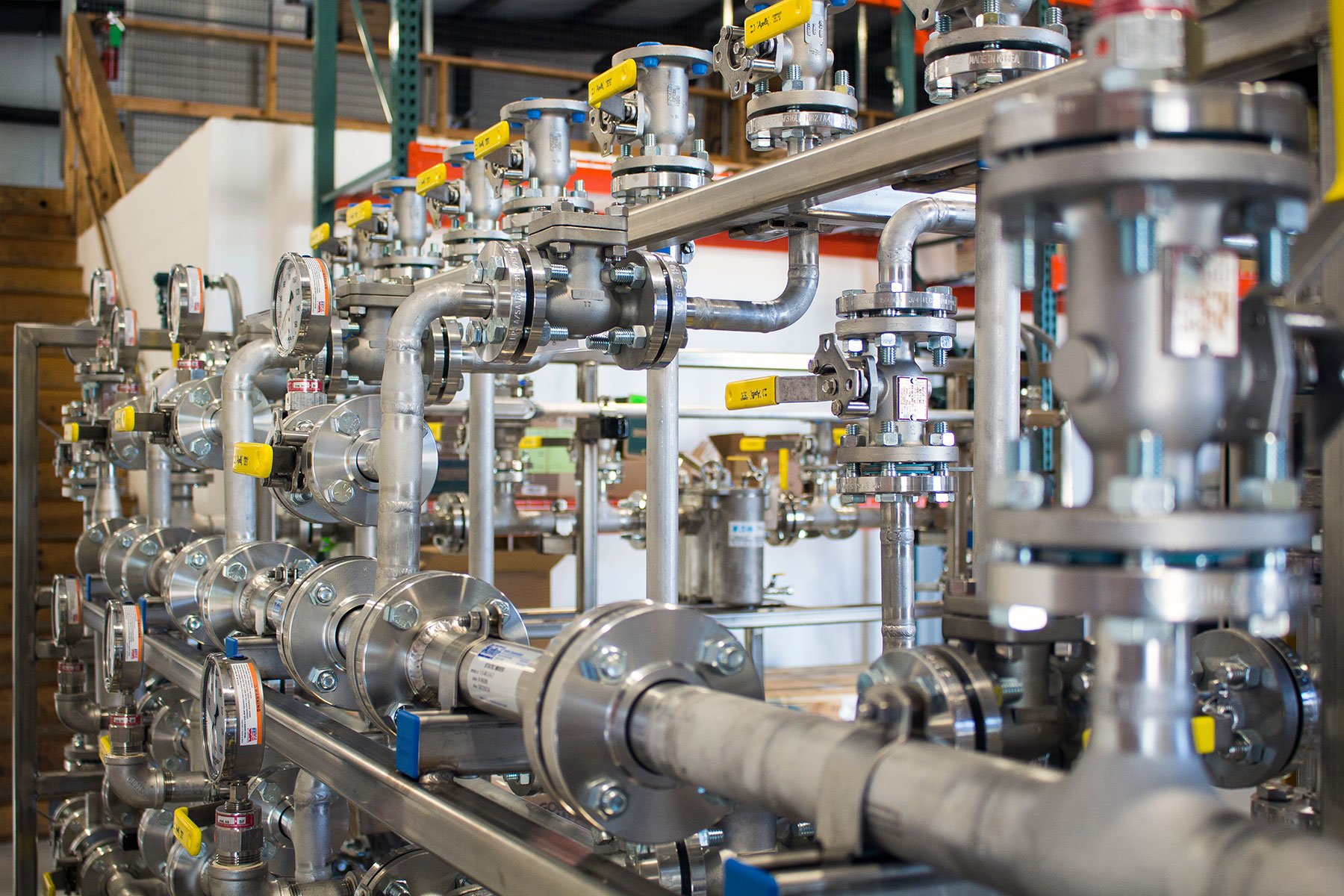There are two methods used when installing a new fluid process. Similar to new home construction, one could choose a stick-built or modular option. With the traditional stick-built approach, all the supplies are delivered to the site and the pumping system is constructed piece by piece. Modular systems, or packaged skid systems, are constructed inside a controlled environment where all supplies are readily available, and all components are fabricated and fitted to a frame.
There are several advantages to modular systems that prompt manufacturers to look to them before “stick-built” systems. Read on to find out why.
 Skid mounted pump systems are fast becoming the solution for many manufacturers. Instead of piecing together a component-based pumping system, compact, pre-engineered, skid mounted units are more attractive than ever.
Skid mounted pump systems are fast becoming the solution for many manufacturers. Instead of piecing together a component-based pumping system, compact, pre-engineered, skid mounted units are more attractive than ever.
Skidded systems are contained within a frame so it’s transportable as a unit from the skid manufacturer to the installation site. Staying within this frame also means it takes less floor space than a traditional installation.
Skid systems are designed to be plug and play. Quality skid systems arrive on the dock ready to install with minimal connection points. They are designed to be as compact as possible while still providing access points to important components.
It is important to note that skid systems are not always the right answer. If components of the system are too large to fit inside the frame, the traditional installation is preferred.
Contact us for a pump skid system.
Skidded systems are used in nearly all markets in one way or another. They’re commonly used in these types of applications:
 Chemical feed
Chemical feedContact us for a pump skid system.
Great skid design starts with a well-defined goal. How do you want to change your process? Do you need to control flow, pressure, or temperature? Is it all of the above? Get specific about your needs, quantify your goals and put numbers to them.
Define exactly what your skid system needs to do, the chemicals used, and how accurate it needs to be. Some processes require very high accuracy, while others do not. Take the time to think about how your new system will fit into your current operation and how it may affect other processes down the line.
Next, consider the resources you have available. What utilities will you need to operate the new system? Is there space available? Do you have a budget?
Knowing the performance details upfront will allow the skid manufacturer to offer their best price and fastest delivery. Contact us for a pump skid system.
Simple systems, like those that consist of few components, are sometimes designed and constructed by the manufacturer. However, it saves a manufacturer time and money by outsourcing more complex systems to companies that engineer and build skid mounted process equipment as part of their business.
When seeking a partner to help design and build a skid system, look for a manufacturer that exhibits these qualities:
Contact us for a pump skid system.
Outsourcing a turn-key solution to one company can take a huge load off your plate. Even a small system requires the oversight of mechanical and electrical designers, procurement of components from multiple vendors, drawings, documentation, and the coordination of several trades from maintenance and operations, plus outside resources.
Experienced skid system manufacturers build systems to minimize the work required to install on site. They focus on delivering the easiest setup possible.
They also ensure the system works as expected before it arrives. The system is put through a series of tests to confirm it delivers performance within the parameters laid out at the beginning of the process. Experienced skid system manufacturers also check to see there are no leaks, the motors are turning in the right direction, programming is de-bugged, valves are adjusted, etc. Running these tests ahead of time reduces the amount of time employees must spend on setup and testing before start up.
Scheduling problems are common on projects. If one contractor has a conflict, it can cause a ripple effect with your schedule, where additional contractors will have to be rescheduled, further delaying the project.
When implementing your own system, what happens if it doesn’t work? Service and performance problems can turn into a finger-pointing nightmare between vendors. When you select one system manufacturer, issues are resolved faster.
Reduced cost? Isn’t it always less expensive to do it yourself?
People are often short-sighted on this point. Imagine a scenario where a manufacturer needs to meter a chemical into a process. They compare the cost of all components (pump, motor, variable frequency drive, flowmeter, etc.) to the cost of a complete system. The cost of the complete system is more, so they decide to take the project on themselves.
There are a few other factors that didn’t make it into their calculation, however. Small components like valves, gauges, piping, fusing, disconnects, etc. add up too. What about the wages paid for assembly and testing? When these costs are added, oftentimes the pre-packaged skid system is a bargain.
Contact us for a pump skid system.

Headquarters and Service Center
Located outside Green Bay, WI
707 Ford Street
Kimberly, WI 54136
920-733-4425
OptiFlow Design and Build Center
1002 Truman Street
Kimberly, WI 54136
920-733-4425
Burnsville Service Center
12265 Nicollet Avenue
Burnsville, MN 55337
952-444-1949
Grand Rapids Service Center
26489 Industrial Blvd
Cohasset, MN 55721
952-444-1949
© Copyright 2024. Crane Engineering. All Rights Reserved. Privacy Policy.